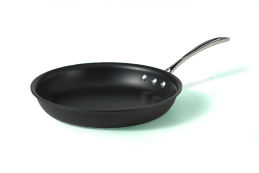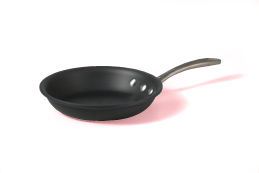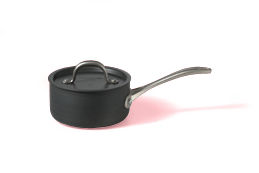 For stock pots, weight (thickness, really) is not so important, and
it’s possible to find ones so big they more closely resemble
swimming pools than pots. Get a sturdy one between 28 and 32
quarts.
For stock pots, weight (thickness, really) is not so important, and
it’s possible to find ones so big they more closely resemble
swimming pools than pots. Get a sturdy one between 28 and 32
quarts.
Brevity may well be the soul of wit, so here’s the condensed version of my advice on pots and pans: Buy the heaviest ones you can find. Buy the biggest ones you can find. Do not buy pots or pans with non-stick surfaces (such as Teflon); buy anodized aluminum, stainless steel, or porcelain enamel only.
If you want to know (a lot) more, keep reading …
There are two exceptions to the rules I’ve just given you: stock pots and omlette pans.
 For stock pots, weight (thickness, really) is not so important, and
it’s possible to find ones so big they more closely resemble
swimming pools than pots. Get a sturdy one between 28 and 32
quarts.
For stock pots, weight (thickness, really) is not so important, and
it’s possible to find ones so big they more closely resemble
swimming pools than pots. Get a sturdy one between 28 and 32
quarts.
Omlette pans need to be every bit as heavy as your other pots and pans, but in this one case (and only in this case) you want a non-stick surface. Buy exactly one 10 inch omlette pan; make sure it has sloping sides. I strongly suggest the Calphalon “Commercial Nonstick,” model C1390 (shown at right).
Still with me? Good.
With respect to heat characteristics, silver is the ideal material for pots and pans. Realistically, though, there are two choices worth considering: heavy-gauge aluminum and cast iron. Sure, there are other materials; I don’t recommend them.
On the whole, heavy-gauge aluminum is the most practical choice and offers the best compromise. With a few exceptions, my cookware collection consists exclusively of Calphalon “Professional Hard Anodized” pieces. It appears that this line is no longer available, but the “Commercial Hard Anodized” series would do just as nicely. If I had to buy all new pots and pans today I might also consider the All-Clad “MC2” (formerly “Master Chef”) or “LTD” series (both with aluminum bodies and stainless steel cooking surfaces).
I own (and recommend) two 8 inch cast iron skillets (made by Lodge), for cooking steaks. You ought to be able to find them for about US$14 each. (They used to be US$7 each, before they brought out their pre-seasoned models. They claim to still make the unseasoned ones, but I’ll be damned if I can find them anywhere.) Actually, you’ll want one skillet per steak, up to the number of burners on your stove; even at US$14 each this is still less than the cost of one good Calphalon pot.
I hope someday to buy a 13 quart “French oven” (sometimes also called a “Dutch oven”) made by Le Creuset. These babies are cast iron with a porcelain enamel finish inside and out; they weigh a ton, cost a lot, and are worth every penny (typically around 28,500 of them) if you ever want to simmer something for hours and not worry about it burning or sticking or reacting with the metal. To be sure, All-Clad makes a series of heavy-duty aluminum pots with stainless steel cooking surfaces, but even those will burn food if left untended for too many hours. (To be fair, so will the Le Creuset pots, but it takes longer and if it does happen the clean-up is easier.) Until I can afford this Le Creuset monster I make do with a Farberware “Classic Series” 8 quart stainless steel stock pot with an aluminum bottom.
I have a cheap aluminum pot with a steamer insert and tight-fitting lid. It gets used frequently but only for vegetables (it burns everything else). I love it. Ignore everything I have to say about weight and materials and buy yourself one of these.
The last exception worth noting is my stock pot. See the paragraph near the top of this page. Mine is 28 quarts.
 |
 |
 |
Now then, sizes and shapes …You will need at least one frying pan (or saute pan), a few sauce pans, and at least one sauce pot. In my essay on knives I urged you to buy a single knife and use it for everything; not so for pots and pans. For a given quantity of food and a particular cooking method, the wrong pot or pan doesn’t just make the job harder; it can actually ruin the dish or make it impossible to achieve the desired results. Start with three or four, then every time you find you need a particular size or shape that you don’t have, go out and buy it.
The differences between omlette pans, frying pans, and saute pans is primarily how much the sides of the pan slope away from the bottom. The sides of an omlette pan flare the most, to make it easy to slide the omlet out of the pan. Frying pan sides slope gently to prevent steam from building up inside the pan. Saute pans have (almost) straight sides so the food "jumps" back into the pan when shaken. For most people, the difference between a frying pan and a saute pan is too subtle to matter; also, many manufacturers sell things called saute pans that are really more like frying pans. If you plan to make omlettes, make sure the pan you buy has sloped sides -- the more slope the better. A 7 inch or 8 inch pan will make a somewhat thick three-egg omlette; in a 9 or 10 in pan it comes out slightly too thin; I have a 10 inch, but would trade down to 9 inches if I could. Then again, I don’t like the egg part of my omlette to be too thick.
Whether you plan to make omlettes or not, get yourself a 10 inch frying pan or saute pan. Unlike your omlette pan, this one should not have a non-stick surface; please, only anodized aluminum or stainless steel.
Sauce pans are about as wide as they are tall, and usually have one long handle; larger ones may have a small (loop) handle as well. Use these pans for sauces, reheating small soups (soups should always be made in your largest pot), rice, etc. Start with a 2 quart, and either a 1 quart or 3 quart pan. My preference is five of these: 1 quart up to 4 quarts (by quarts) and a 1/2 quart “baby” for melting butter and heating very small quantities of liquids. My 4 quart pan gets the most use, but that’s because it’s the perfect size for shaped pasta for my wife and me.
At 5 quarts you’ll want what some companies call a “saucier pan” and others call a “sauteuse pan.” Whatever the correct name is, these pans are about twice as wide as they are high, and usually have two short (loop) handles. If it has a long handle they’re sometimes called “saute pans.” Anyway, mine looks like this:
Of all the pots and pans I own this one gets used more than any of the others: It’s the right size for cooking so many of the dishes I like, and it’s height makes it ideal for browning large quantities of meat or poultry (which is something I do a lot). You can find smaller versions of this pan (typically 3 1/2 quarts), but unless you only ever cook very small quantities of food the 5 quart size is the way to go.
At 6 quarts you’re into the pot category; “soup pot,” “sauce pot” -- call them what you will. Most sizes are somewhat taller than they are wide (with stock pots typically being on the order of twice as tall as they are wide). If you have to buy just one, go for 8 quarts; as soon as you can afford it add a 16 quart, then a 12, then maybe a 6. (I don’t think I’ve ever seen a 10 quart or a 14 quart pot; I’ve certainly never wanted one.) For soup, 8 quarts is the minimum, but 12 is better. Most soups freeze very well, and many even improve after having been frozen. For the effort they require, you may as well make them in the biggest batches you can manage. My 28 quart stock pot is my choice when I make vegetable soup.
Don’t forget that you can't actually make 12 quarts of soup in a 12 quart pot; always leave yourself a few quarts of room so you can mix and stir without creating a flood on your stove. Use your 16 quart pot for soup, even if you fill it only half way (but a generous three-quarters would be better), and save your 8 quart for tomato sauce, stews, etc.
| [Up to the recipe index] | [Abbreviations] | [Back to AdamM's home page ] |